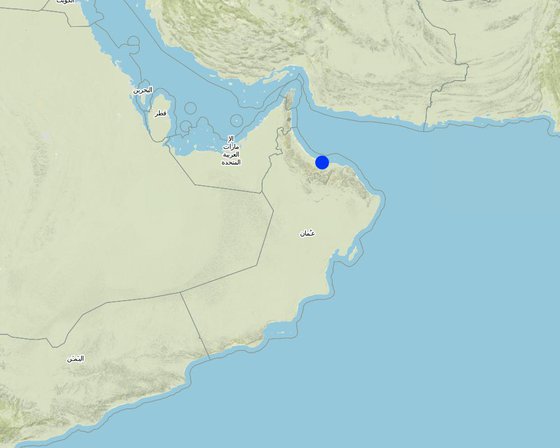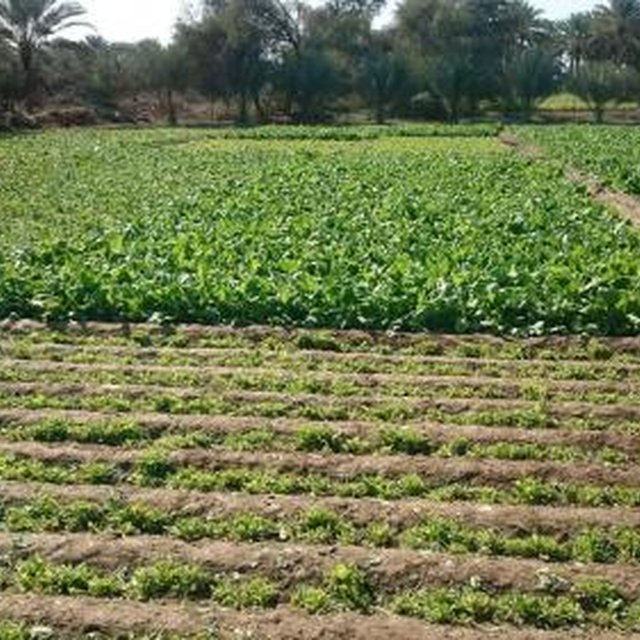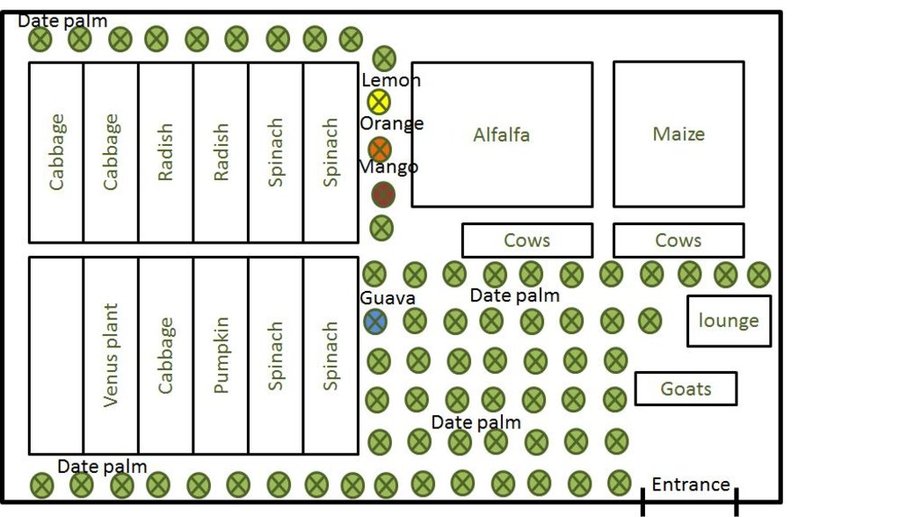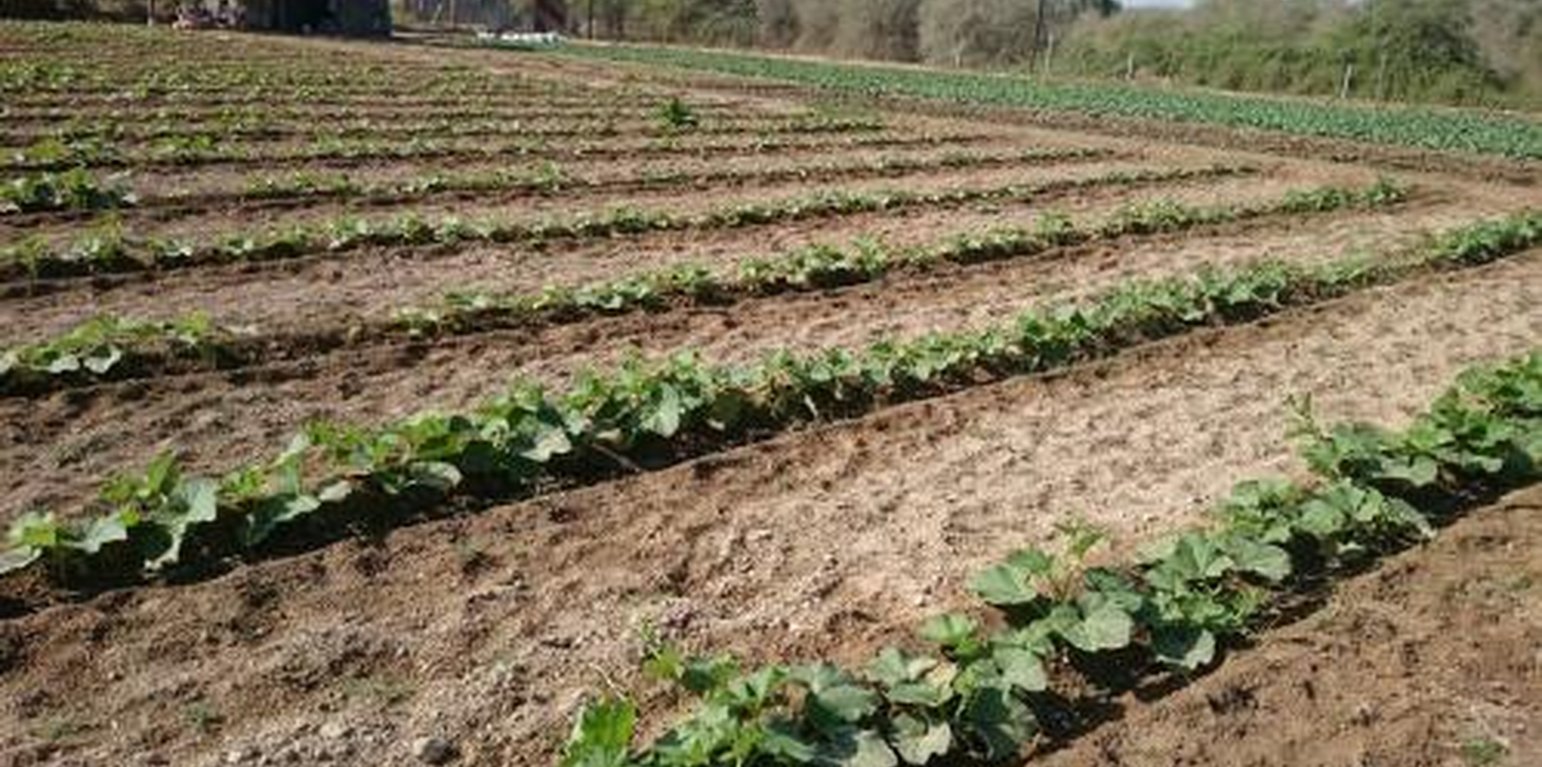Vegetables in salt affected soil
(Oman)
زراعة الخضروات في الترب المالحة
Description
Growing variety of vegetables in salt affected soils.
The farm is 5 faddan in area. Vegetables such as eggplants, parsley, spinach and pumpkin are planted in part of the farm on a rotational basis. In the remaining small area other crops which includes rhodes, maize, banana, alfalfa and date palms are grown.
Livestock are part of the farm business from whch substational income is obtained by the household.
Purpose of the Technology: To earn income that suports the livelihood of the household.he income i generated from vegetables, fruits and livestock products.
Establishment / maintenance activities and inputs: Vegetables are established in direct seeding and fruit trees are established in direct seedlings. Seedlings are bought from commercial nurseries.
Natural / human environment: The farm is located in a flat area along the oman sea coast. Most of the farmers in surounding area
Location

Location: Al Massenah, Al Batinah, Oman
No. of Technology sites analysed:
Geo-reference of selected sites
Spread of the Technology: evenly spread over an area (0.021 km²)
In a permanently protected area?:
Date of implementation: 10-50 years ago
Type of introduction
-
through land users' innovation
-
as part of a traditional system (> 50 years)
-
during experiments/ research
-
through projects/ external interventions

Radish that grown in salt affacted soils (Eng.Badria Alhosni (Oman))
Classification of the Technology
Main purpose
-
improve production
-
reduce, prevent, restore land degradation
-
conserve ecosystem
-
protect a watershed/ downstream areas – in combination with other Technologies
-
preserve/ improve biodiversity
-
reduce risk of disasters
-
adapt to climate change/ extremes and its impacts
-
mitigate climate change and its impacts
-
create beneficial economic impact
-
create beneficial social impact
Land use
-
Cropland
- Annual cropping: vegetables - leafy vegetables (salads, cabbage, spinach, other), vegetables - other
- Tree and shrub cropping
Water supply
-
rainfed
-
mixed rainfed-irrigated
-
full irrigation
Purpose related to land degradation
-
prevent land degradation
-
reduce land degradation
-
restore/ rehabilitate severely degraded land
-
adapt to land degradation
-
not applicable
Degradation addressed
-
other - Specify: Secondary causes of degradation: crop management (annual, perennial, tree/shrub)
SLM group
-
improved plant varieties/ animal breeds
SLM measures
-
agronomic measures - A1: Vegetation/ soil cover
-
vegetative measures - V2: Grasses and perennial herbaceous plants
-
management measures - M1: Change of land use type
Technical drawing
Technical specifications
Location: AlMusinah. AlBatina South
Date: 06/01/2016
Technical knowledge required for land users: low
Main technical functions: increase in organic matter
Secondary technical functions: improvement of ground cover, increase in nutrient availability (supply, recycling,…), increase of biomass (quantity)
Change of land use type
Change of land use practices / intensity level
Control / change of species composition

Author: Eng.Fatima AlKharosi, Oman
Establishment and maintenance: activities, inputs and costs
Calculation of inputs and costs
- Costs are calculated:
- Currency used for cost calculation: Omani Rial
- Exchange rate (to USD): 1 USD = 0.39 Omani Rial
- Average wage cost of hired labour per day: n.a
Most important factors affecting the costs
n.a.
Establishment activities
-
labour (Timing/ frequency: None)
Establishment inputs and costs
| Specify input |
Unit |
Quantity |
Costs per Unit (Omani Rial) |
Total costs per input (Omani Rial) |
% of costs borne by land users |
|
Labour
|
| Labour |
unit |
2.0 |
60.0 |
120.0 |
|
| Total costs for establishment of the Technology |
120.0 |
|
| Total costs for establishment of the Technology in USD |
307.69 |
|
Maintenance activities
n.a.
Natural environment
Average annual rainfall
-
< 250 mm
-
251-500 mm
-
501-750 mm
-
751-1,000 mm
-
1,001-1,500 mm
-
1,501-2,000 mm
-
2,001-3,000 mm
-
3,001-4,000 mm
-
> 4,000 mm
Agro-climatic zone
-
humid
-
sub-humid
-
semi-arid
-
arid
Specifications on climate
Thermal climate class: tropics
Slope
-
flat (0-2%)
-
gentle (3-5%)
-
moderate (6-10%)
-
rolling (11-15%)
-
hilly (16-30%)
-
steep (31-60%)
-
very steep (>60%)
Landforms
-
plateau/plains
-
ridges
-
mountain slopes
-
hill slopes
-
footslopes
-
valley floors
Altitude
-
0-100 m a.s.l.
-
101-500 m a.s.l.
-
501-1,000 m a.s.l.
-
1,001-1,500 m a.s.l.
-
1,501-2,000 m a.s.l.
-
2,001-2,500 m a.s.l.
-
2,501-3,000 m a.s.l.
-
3,001-4,000 m a.s.l.
-
> 4,000 m a.s.l.
Technology is applied in
-
convex situations
-
concave situations
-
not relevant
Soil depth
-
very shallow (0-20 cm)
-
shallow (21-50 cm)
-
moderately deep (51-80 cm)
-
deep (81-120 cm)
-
very deep (> 120 cm)
Soil texture (topsoil)
-
coarse/ light (sandy)
-
medium (loamy, silty)
-
fine/ heavy (clay)
Soil texture (> 20 cm below surface)
-
coarse/ light (sandy)
-
medium (loamy, silty)
-
fine/ heavy (clay)
Topsoil organic matter content
-
high (>3%)
-
medium (1-3%)
-
low (<1%)
Groundwater table
-
on surface
-
< 5 m
-
5-50 m
-
> 50 m
Availability of surface water
-
excess
-
good
-
medium
-
poor/ none
Water quality (untreated)
-
good drinking water
-
poor drinking water (treatment required)
-
for agricultural use only (irrigation)
-
unusable
Water quality refers to:
Is salinity a problem?
Occurrence of flooding
Characteristics of land users applying the Technology
Market orientation
-
subsistence (self-supply)
-
mixed (subsistence/ commercial)
-
commercial/ market
Off-farm income
-
less than 10% of all income
-
10-50% of all income
-
> 50% of all income
Relative level of wealth
-
very poor
-
poor
-
average
-
rich
-
very rich
Level of mechanization
-
manual work
-
animal traction
-
mechanized/ motorized
Sedentary or nomadic
-
Sedentary
-
Semi-nomadic
-
Nomadic
Individuals or groups
-
individual/ household
-
groups/ community
-
cooperative
-
employee (company, government)
Age
-
children
-
youth
-
middle-aged
-
elderly
Area used per household
-
< 0.5 ha
-
0.5-1 ha
-
1-2 ha
-
2-5 ha
-
5-15 ha
-
15-50 ha
-
50-100 ha
-
100-500 ha
-
500-1,000 ha
-
1,000-10,000 ha
-
> 10,000 ha
Scale
-
small-scale
-
medium-scale
-
large-scale
Land ownership
-
state
-
company
-
communal/ village
-
group
-
individual, not titled
-
individual, titled
Land use rights
-
open access (unorganized)
-
communal (organized)
-
leased
-
individual
Water use rights
-
open access (unorganized)
-
communal (organized)
-
leased
-
individual
Access to services and infrastructure
Impacts
Socio-economic impacts
risk of production failure
production area (new land under cultivation/ use)
Socio-cultural impacts
livelihood and human well-being
Ecological impacts
nutrient cycling/ recharge
soil organic matter/ below ground C
Cost-benefit analysis
Benefits compared with establishment costs
Short-term returns
very negative
very positive
Long-term returns
very negative
very positive
Benefits compared with maintenance costs
Short-term returns
very negative
very positive
Long-term returns
very negative
very positive
Climate change
Gradual climate change
annual temperature increase
not well at all
very well
Climate-related extremes (disasters)
not well at all
very well
Adoption and adaptation
Percentage of land users in the area who have adopted the Technology
-
single cases/ experimental
-
1-10%
-
11-50%
-
> 50%
Of all those who have adopted the Technology, how many have done so without receiving material incentives?
-
0-10%
-
11-50%
-
51-90%
-
91-100%
Has the Technology been modified recently to adapt to changing conditions?
To which changing conditions?
-
climatic change/ extremes
-
changing markets
-
labour availability (e.g. due to migration)
Conclusions and lessons learnt
Strengths: land user's view
Strengths: compiler’s or other key resource person’s view
Weaknesses/ disadvantages/ risks: land user's viewhow to overcome
Weaknesses/ disadvantages/ risks: compiler’s or other key resource person’s viewhow to overcome
References
Reviewer
-
David Streiff
-
Alexandra Gavilano
Date of documentation: Junie 7, 2016
Last update: Junie 12, 2019
Resource persons
-
Badria Alhosni - SLM specialist
-
jamaan rabeea - SLM specialist
-
Hamood Al-Hashmi - SLM specialist
-
Nasser Al-Wahaibi - SLM specialist
-
Rahma Al Habsi - SLM specialist
-
Fatma Alkharusi - SLM specialist
-
Fatima AL Abri - SLM specialist
-
Hamdan Al-Wehaibi - SLM specialist
Full description in the WOCAT database
Documentation was faciliated by
Institution
- Sultan Qaboos University (SQU) - Oman
- Test institution (TI) - Albania
Project











